| Article ID | Journal | Published Year | Pages | File Type |
|---|---|---|---|---|
| 6368134 | Water Research | 2011 | 11 Pages |
Abstract
Sewage water treatment plants (STPs) are frequently associated with the release of xenobiotics and, consequently, with biological responses of fish to these substances. The impact of three STPs situated on small streams was assessed in 2009. Brown trout (Salmo trutta fario L.), captured upstream and downstream of these STPs, were used as biomonitors. The concentrations of 39 organic pollutants (PCBs, OCPs, PBDEs, HBCDs, and MCs), and the biological responses related to oxidative stress (lipid peroxidation and carbonyl protein), and antioxidant responses (superoxide dismutase, glutathione peroxidase and glutathione reductase) were measured. Through chemometrics of these parameters, three groups with 97.62% of the total accumulated variance were distinguished. Integration of the assessed biomarkers using the IBR index, ranked environment impact on sites as: DS Pacov > DS Prachatice > DS Brloh > US Pacov > US Prachatice > US Brloh (most to least affected). STPs are a major source of xenobiotic pollution in streams of the Czech Republic. The combined use of chemical analysis and biological responses is necessary to validate the efficacy of a battery of biomarkers chosen to detect environmental stress due to pollution.
Related Topics
Physical Sciences and Engineering
Earth and Planetary Sciences
Earth-Surface Processes
Authors
Zhi-Hua Li, Vladimir Zlabek, Jan Turek, Josef Velisek, Jana Pulkrabova, Jitka Kolarova, Eliska Sudova, Petra Berankova, Petra Hradkova, Jana Hajslova, Tomas Randak,
